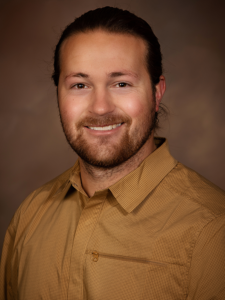 Electrical and computer engineering assistant professor and director of the Utah NeuroRobotics Lab, Jacob George, was recently featured in a Q&A session published in The Superposition, a publication investigating emerging technologies, scientific breakthroughs, and communications strategies driving the advancement of modern society. The interview explores topics like breakthroughs in neurorobotics, current trends in AI and brain-computer interfaces and their potential to cure obesity, robot bodies storing our memories, patient needs, the metaverse and more.
Electrical and computer engineering assistant professor and director of the Utah NeuroRobotics Lab, Jacob George, was recently featured in a Q&A session published in The Superposition, a publication investigating emerging technologies, scientific breakthroughs, and communications strategies driving the advancement of modern society. The interview explores topics like breakthroughs in neurorobotics, current trends in AI and brain-computer interfaces and their potential to cure obesity, robot bodies storing our memories, patient needs, the metaverse and more.
George also explains the motivation behind the “LUKE Arm,” a thought-controlled bionic arm developed by his lab that can restore a sense of touch to its users. The device was recently featured in Mind Matter News alongside other exciting work from MIT.
“Your hands are also fundamental to your sense of self. Think about how much of the world is perceived through your hands, for example, when holding hands with a loved one or physically feeling the world that’s around you. Our hands are a fundamental part of who we are, which is an important reason to focus on it,” George told The Superposition.
The device functions through a series of advanced sensors capable of detecting pressure, movement, and other types of perception. Electrodes implanted in the participant’s arm provide a bi-directional link between the remaining nerves in the limb and the prosthesis allowing the hand to move in response to thought. When the arm makes contact with an object, signals pass from the device to a nearby computer that converts it into a message understood by the brain, providing the user with a sense of touch. While improvements are still needed to make the prosthesis more affordable and less dependent on a nearby computer, the device is the most sensitive of its kind to date, and the work has exciting potential for a variety of neural interfaces that could treat several different neurological impairments.
Georges lab is now working on a non-invasive way of stimulating the arm nerves to reanimate limbs with partial paralysis after a stroke or spinal cord injury. They’ve also begun recruiting patients to help evaluate new neuromuscular and sensory diagnostics and rehabilitative tools, including a “self-aware” bionic arm that functions autonomously, working in conjunction with the human user. George believes bionic devices will not only one day restore lost functionality among individuals but potentially enhance dexterity beyond their normal capabilities.
Learn more about the Georges lab’s groundbreaking work by reading the full stories at The Superposition and Mind Matter News.